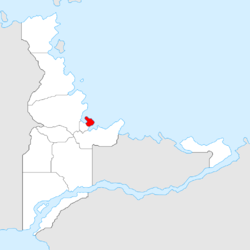Erstveda
| Erstveda | |||
|---|---|---|---|
| Province of Gerenia | |||
|
|||
 |
|||
| Nation | |||
| Established | 8 July 2012 | ||
| Capital | Port Elerat | ||
| Government | |||
| • Governor | Peder Mesalte (SPG) | ||
| Area | |||
| • Total | 5,220 km2 (2,020 sq mi) | ||
| Area rank | 12th | ||
| Population (2018) | |||
| • Total | 1,810,618 | ||
| • Rank | 1st | ||
| • Density | 346.86/km2 (898.4/sq mi) | ||
| Demonym | Erstvedan | ||
Erstveda is a province in Gerenia. It is the most populous and the most densely populated of the provinces of Gerenia, despite being the least extensive. Erstveda is bordered by Ramez to the south, as the rest of the border is maritime.
Port Elerat, with a population of over 1.1 million, is the most populous city in Gerenia. Alone, it makes up over 70% of the population of Erstveda.
History
When the Gerenian State was established in Micras, the Panormos Peninsula received the so-called "northern migratory tendency", mainly composed by the Oseski and Musleki tribes of Meeredres, and led by Lord Isherwood. A settlement (to become Port Isherwood, now Port Elerat) was rapidly founded on the ruins of Serdste, the capital of the disappeared Students' Isocratic Oligarchy of Yabloko. The province was founded as "Isherwood".
Since the establishment of Gerenia, the province began a process of industrialization. However, this was limited to the southern region of it, while the north and the east of the province remained little inhabited.
In 2015, the province name was changed to "Erstveda".
Geography
Erstveda occupies the entire Panormos Peninsula. In contrast with Port Elerat's urban atmosphere, the vast majority of the state is dominated by forests. The province's rural areas and small towns on the coast of the Northern Sea contrast shaply with Port Elerat.
The Maiŷnat River cuts through the south of the province, flowing into Pezara Bay.
The climate is subarctic in the north and west of the province, heavily influenced by the winds coming from the north, and consisting on treeless tundra. In the south, the climate is oceanic, with warm summers, and cold winters. Precipitations in form of rains are frequent.
| |||||

